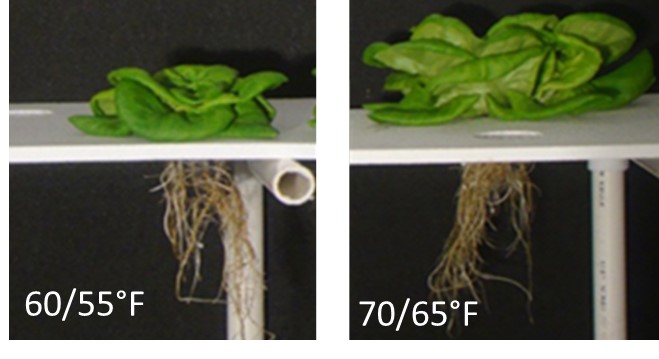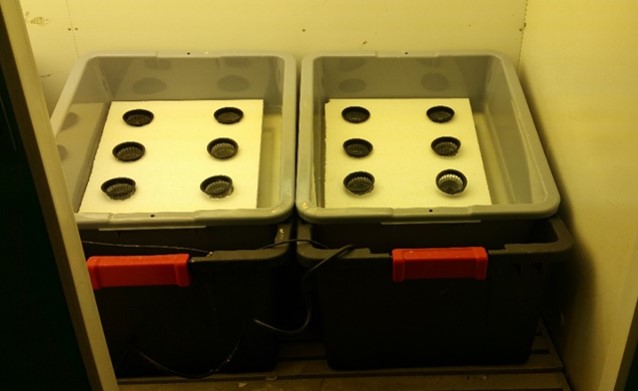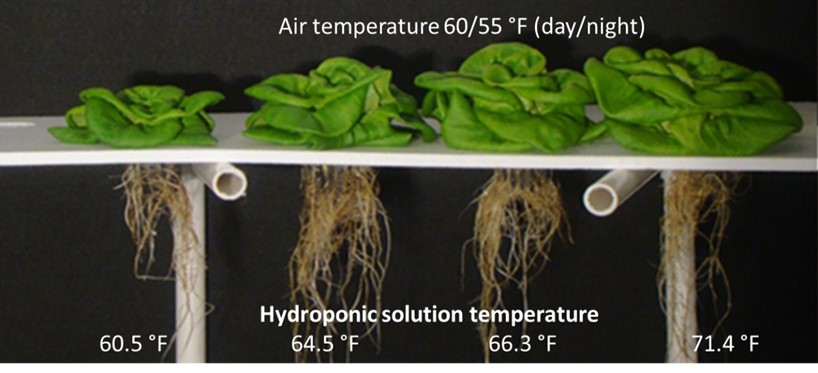Alex Miller† and Krishna Nemali††
† Graduate student, Horticulture and Landscape Architecture, Purdue University
†† For correspondence: knemali@purdue.edu
Lettuce is one of the major leafy greens grown in hydroponic greenhouses. Lettuce production in greenhouses during winter can provide year-round income to Indiana hydroponic growers. Many growers assume that lettuce is a cool season crop and can be grown at lower air temperature of 55 to 60 oF. In our experiments, we tightly maintained air temperature for butter head lettuce var. REX at 60/55 and 70/65 oF (light/dark) for a period of 28 days and found that plants grown at 70/65 oF were considerably larger than those grown at 60/55 oF (Fig. 1). The average shoot fresh weight per plant was 19.6 and 69.5 g under 60/55 and 70/65 oF, respectively. This study shows that greenhouse temperature has to be maintained near 70/65 oF for growing lettuce. However, energy cost of heating can be high during winter and reduce profits in lettuce production, making it less attractive to greenhouse growers.

Figure 1. Butter head lettuce var. Rex grown continuously under tightly maintained air temperature of 60/55 and 70/65 oF for 28 days
The ‘conventional method’ of heating greenhouse air may not be efficient because the entire greenhouse is heated whereas plants occupy a small space inside the greenhouse. Therefore, developing efficient heating methods is crucial for sustainability of hydroponic lettuce production during winter. Published research indicates that, increasing hydroponic solution temperature can increase lettuce growth (Sakamoto and Suzuki, 2015). We conducted an experiment using butter head lettuce and heated hydroponic solution under cooler air temperature conditions. In this experiment, we wanted to (i) identify optimal temperature of the hydroponic solution for maximizing butter head lettuce growth when air temperature is maintained at 60/55 oF (day/night) and (ii) compare heating efficiency (crop yield per oF rise in temperature) under different treatments.
This study was performed in a climate-controlled growth chamber to ensure tight control of ambient air temperature and light intensity during production. Seeds of butter head lettuce (Lactuca sativa ‘Rex’) were germinated in 1-inch rockwool cubes placed on sub-irrigation trays. After germination, seedlings were transferred to a custom-built hydroponic culture system (Fig. 2). This system consisted of a reservoir and production tray (Fig. 2). A one-inch thick styrofoam sheet with holes for net pots was placed on top the tray. Germinated seedlings were placed inside the net pots, which were spaced 8” x 6” apart in each tray. A total of six plants were grown in a tray. The reservoir contained approximately 10 gallons of nutrient solution. A film of nutrient solution was recirculated between the reservoir and trays using a submersible pump. A flex tubing from the pump was connected to the inlet of the tray. The outlet of the tray drained directly into the reservoir. An aquarium heater was used to increase the nutrient solution temperature in the reservoir. A total of four similar production systems were built for conducting the experiment.

Figure 2. Custom built hydroponic production systems consisting of reservoirs, trays, styrofoam sheets and net pots
Air temperature was maintained at 60/55 oF (day/night) inside the growth chamber. Plants received approximately 11.5 mol m-2 d-1 of light during a 16-hour photoperiod. The nutrient solution was maintained at an EC of 1.8 and pH range of 5.5 to 6.5. The fertilizer supplied was prepared by mixing 20-10-20 (20% N, 5.6% P, 17.2% K) and 15-5-15 (15% N, 2.5% P, 12.6% K) water-soluble formulations in 3:1 ratio. Fresh nutrient solution was added to the reservoirs twice a week during the study. Plants were grown under four different nutrient solution temperature treatments (60.5, 64.5, 66.3, and 71.4 oF). The lowest solution treatment did not contain a heater, while other solution temperature treatments were achieved using heaters and adjusting heater set points (Fig. 3). Plants were grown under different treatments for a period of 28 days. At harvest stage, shoots belonging to six plants in each treatment were harvested and their fresh (g) and oven-dried weight (g) were measured. In addition, we measured dry weight of roots. Heating efficiency (Heff) in different treatments was calculated as the ratio of difference in crop yield (CY) to difference in hydroponic solution temperature (T) between heated and unheated treatments:


Figure 3. Butter head lettuce var. Rex grown under different hydroponic solution temperatures when air temperature was maintained 60/55 oF
Our results indicated that crop growth was enhanced when hydroponic solution temperature was increased (Fig. 3). Maximum crop growth was observed under hydroponic solution temperature of 71.5 oF (Fig.3 and Table 1).
Our results also indicate that root growth increased with increasing solution temperature and in part was responsible for increased shoot fresh weight with increasing hydroponic solution temperature. Better root growth may have aided in increased nutrient uptake thereby enhancing shoot growth with increasing hydroponic solution temperature. We did not find any clear trends in shoot temperature of plants among different treatments. This suggests that increased hydroponic solution temperature may have had less effect on shoot temperature of butter head lettuce in our study.
Compared to unheated treatment, heating efficiency increased with increasing hydroponic solution temperature up to a solution temperature of 66.3 °F and decreased at higher solution temperature (Table 1). This indicates that the optimal solution temperature for maximizing heating efficiency is in the range of 66.3 °F.
Table 1. Observed differences in shoot fresh weight and heating efficiency with increasing hydroponic solution temperature

In conclusion, our experimental results suggest that increasing hydroponic solution temperature can enhance the growth of butter head lettuce under cooler air temperature conditions. Maximum growth was observed when hydroponic solution temperature was maintained at 71.4 °F. However, heating efficiency was maximum when hydroponic solution temperature was maintained at 66.3 °F.